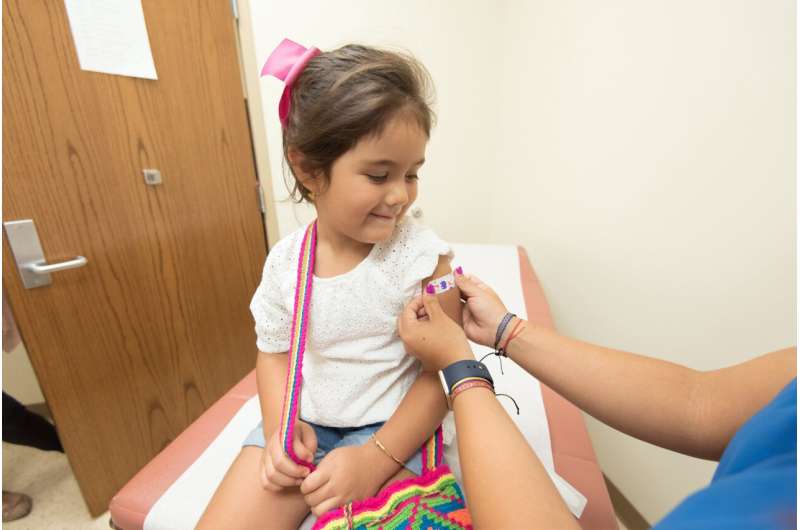This article has been reviewed according to Science X's editorial process and policies. Editors have highlighted the following attributes while ensuring the content's credibility:
fact-checked
reputable news agency
proofread
Vaccines for low-income children lag behind, CDC study finds

A new report released Tuesday by the Centers for Disease Control and Prevention shows gaps remain in Vaccines for Children, a federally-funded program to provide free vaccines to low-income families, with lower vaccination coverage among children living in poverty remaining a persistent problem.
This study comes on the heels of another study by the CDC, which found that over the past 30 years, routine childhood vaccinations have prevented approximately 508 million cases of illness, 32 million hospitalizations and 1.1 million deaths. But despite these substantial health benefits, attitudes toward childhood vaccinations have shifted, and they are an increasingly tough sell.
A Gallup poll published recently found that just 40% of Americans think it's "extremely important" for children to get vaccinated, down from about 64% in 2001.
Reaching families at or below the poverty line can be even more difficult. CDC officials pointed to a lack of confidence and a lack of access to vaccines as key reasons for the lower rates among VFC eligible children. They noted that vaccine uptake in the first year of life is generally higher and then falls especially among vaccinations requiring multiple doses over several years.
"We need to do more," said CDC Chief Medical Officer Dr. Debra Houry at a press briefing Tuesday. "Health care providers are our crucial partners to increase the number of children who complete their vaccine series and reach those children living below the poverty level without health insurance."
The study does not include state specific information, but major findings of vaccination coverage from 2012 to 2022 in the U.S. include:
- Only 61% of children born in 2020 who were VFC-eligible received the seven vaccines known as the "combined 7-vaccine series" by their second birthday. This series includes all recommended doses of diphtheria, tetanus and pertussis (whooping cough) (DTaP) vaccine, polio vaccine, measles, mumps and rubella (MMR) vaccine, the Hib vaccine protecting against Haemophilus influenzae type b bacteria, the hepatitis B vaccine, chicken pox vaccine, and the a vaccine (PCV) that helps protect against bacteria that cause pneumococcal disease. Among children not VFC-eligible also born in 2020, the vaccination rate for this combined 7-vaccine series was 75%.
- About 90% of VFC-eligible children born in 2020 received at least one dose of the measles, mumps and rubella vaccine (MMR) vaccine. Among those not VFC-eligible, coverage rate with at least one dose of MMR vaccine is about 93%.
- Vaccination coverage was also lower among uninsured children than among Medicaid-insured children. Uninsured children are more likely to have not seen a health care provider in the past year. They are less likely to complete vaccine series that require multiple doses. The vaccination rate was about 62% for the combined 7 vaccines for those with Medicaid coverage and about 39% for those without insurance.
Houry pointed to important steps by health care providers to help reassure families about the importance of getting the vaccine, including the following: Offering accurate information on vaccination benefits; giving catch-up vaccines and review for needed vaccines; strengthening relationships with families and setting reminders for families whose children are behind on vaccines.
The Vaccines for Children program supplies vaccines for free to participating providers. Children across the country can be eligible for this program aimed at helping those who would not otherwise be able to afford vaccinations. In Georgia, the vaccines are available to children up to 19 years of age who are:
- Medicaid-enrolled
- Uninsured (child has no health insurance coverage) or underinsured
- American Indian or Alaska Native
The Vaccines for Children program is administered nationally by CDC. The federal government purchases pediatric vaccines at a discount and ships them directly to enrolled VFC vaccine providers in Georgia and across the country. Administrative fees for administering vaccines in this program are generally covered by Medicaid.
There are about 37,000 VFC providers across the country, according to CDC. In Georgia, there are 1,138 VFC providers, which includes public health clinics and private practices. The number has remained steady over the past decade, according to DPH. About half the children in the U.S. receive their vaccinations through the VFC program, according to the CDC.
Overall, vaccination rates for routine childhood shots have still not returned to pre-pandemic levels, according to the CDC.
Vaccination rates in Georgia have also hovered below the national average and well below a critical threshold for keeping once-common, serious illnesses at bay, according to the most recent data available.
In Georgia for the 2023-2024 school year, 88% of kindergartners received routine vaccinations, which include the measles, mumps and rubella (MMR) vaccine; the diphtheria, tetanus and acellular pertussis (DTaP) vaccine; the poliovirus (polio) vaccine; and the varicella (chickenpox) vaccine.
For the U.S. overall, 93% of children in kindergarten met the vaccination requirements.
The coverage rate for incoming kindergartners will likely not be available for several months.
2024 The Atlanta Journal-Constitution. Distributed by Tribune Content Agency, LLC.





















